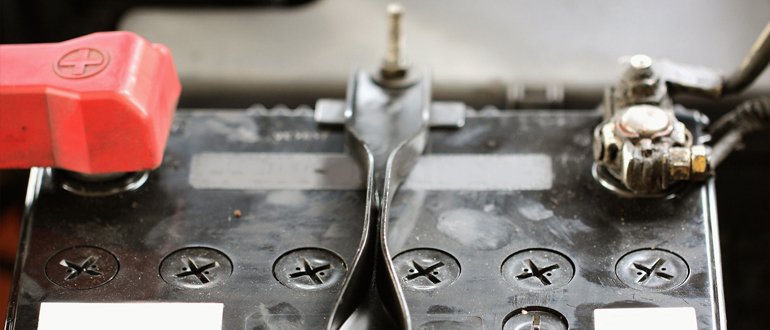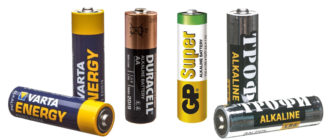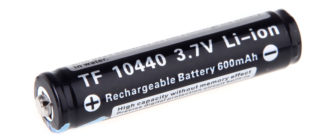Confusing the battery terminals is quite difficult, but such a situation cannot be completely ruled out. If the polarity reversal does occur, then you need to know exactly what to do in this situation and what consequences may come for the battery, as well as the equipment to which the battery is connected.
Content
Is it easy to mess with connecting terminals
In order not to accidentally get confused when connecting the terminals to the batteries, the negative terminal was made thinner than the positive one. That is, it will be very difficult to put a negative one on a positive contact, and a positive one will not be able to just be fixed on a negative contact. In addition, next to each contact will be the designation "+" and "-". Sometimes they are still highlighted in red and black (blue).
If the notation is erased and determining where the “plus” and “minus” does not work, then do not guess. In order not to mess with the connection, it is recommended to use a tester or multimeter to determine the polarity of the battery. Even a very weak battery will be able to supply enough voltage to carry out such a diagnosis.
Poor lighting in rooms or work in the dark can also result in battery polarity reversal. Therefore, even if it is not possible to organize normal lighting, when you connect the battery, you can turn on your cell phone and accurately determine the polarity.
Note! The positive terminal is always thicker than the negative and is indicated by the “+” sign, sometimes there is still a red casing on the contact.
What happens if you mix the battery terminals
The degree of damage during polarity reversal will depend on which devices will be connected to the battery. In some cases, nothing bad will happen, for example, incandescent lamps will work as before, and DC motors will begin to rotate in the opposite direction.
At the same time, LED equipment that is not protected by fuses will instantly fail if not connected correctly. Sophisticated electrical circuits on semiconductor devices will also not withstand and burn out.
When charging the battery
Polarity reversal during battery charging is the most common occurrence. Even experienced car owners can face such a problem. After all, if the clamps on the wires of the car are designed for different diameters of the terminals, then on the chargers at the ends are crocodiles.
If you use a makeshift charger, you should also exercise caution when connecting wires to the battery terminals. Moreover, if such a device was manufactured by other people, then you can easily detect a positive charge on the black conductor, and a negative charge on the red one.
Polarity reversible memory
Many modern charger models are protected against reverse polarity. For this purpose, fuses or self-resetting fuses can be used, which, when the polarity is violated, instantly open the circuit. Such a part can be located on one of the low-voltage wires or in the lower part of the product housing.
The use of protection allows you to fully preserve the performance of the product, but if fusible inserts are used, then to restore the device you will need to replace the burned parts with new ones. If there are no built-in protections, then charging will simply burn out. Nothing should happen to the batteries themselves.
Memory without reverse polarity protection
A charger without protection against reverse polarity can not only fail, but also ignite from high temperatures. The risk of damage to the battery also exists, especially if the battery has been badly discharged.
When using chargers without protection, carefully connect the terminals of the low voltage wires to the battery terminals.
When lighting
If the car does not start, the method of lighting is an excellent solution for quick starting the engine. If in such a situation it is incorrect to connect the wires from one battery to another, then a lot can happen, even an explosion in the battery, which is less charged.
In practice, such actions can be compared with if the owner of the machine shorted the positive conductor to ground, but only with a large 2-fold discharge current. Also in this case, a fire may occur as a result of the release of a very large amount of heat.
In addition, often there is a need to repair the electrical equipment of both cars after an incorrect connection. Battery life will also be significantly reduced if the wires are incorrectly connected when lighting.
When connected to a car
If the contact between the power wires and the battery is not made correctly, sensitive elements such as a generator rectifier and a relay regulator may fail. Other equipment may be protected by fuses that are fired first.
More powerful electrical equipment, such as a starter, will not be damaged, but it will be impossible to start the engine of the car on which the battery is improperly installed.
What to do when reversing
The first thing to do when reversing is to disconnect the battery from the charger, car wires or other load as soon as possible. Then you should examine the place where the polarity violation occurred.
If signs such as small smoke or smoldering of the material of the connected device are observed, then the first signs of fire should be correctly eliminated with a carbon dioxide fire extinguisher or sand or water. If there is a strong fire of oil products, then it is not recommended to use water.
After making sure that during the incorrect connection of the battery there was no fire, an assessment is made of the condition of the battery and the devices connected to the network. This is best done by an electrician in a car workshop, and without special knowledge, a complete diagnosis will not work.
If the battery has warmed up, it must be allowed to cool before carrying out diagnostic measures. Then using a multimeter check the voltage at the terminals. If this value is more than 13 volts, then most likely the battery can be used further without any restrictions. Otherwise, the battery is charged.
With a working battery, you should try to install it on the car and try to start the engine. If this procedure was successfully carried out, then check all the electrical equipment of the car. When identifying the inoperability of the on-board electronics elements, it is necessary to contact qualified specialists for repair work.









